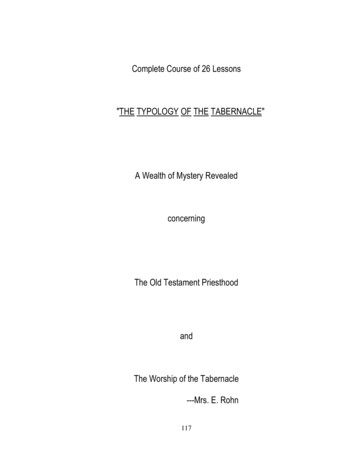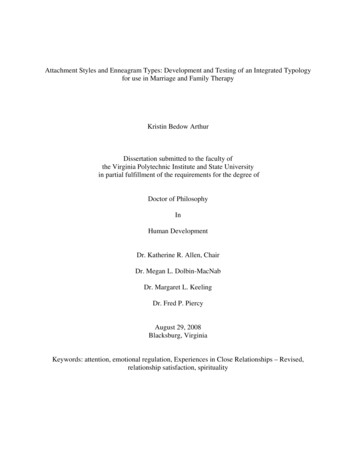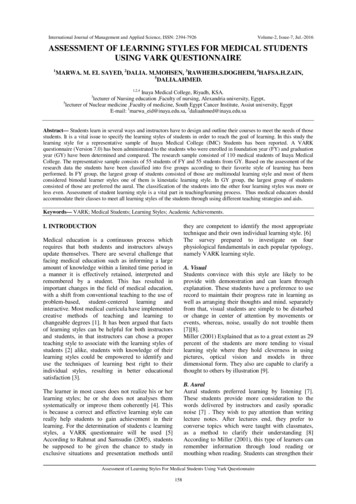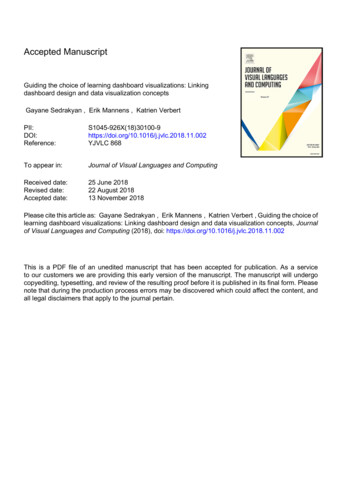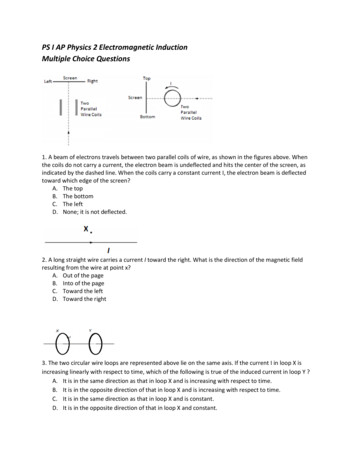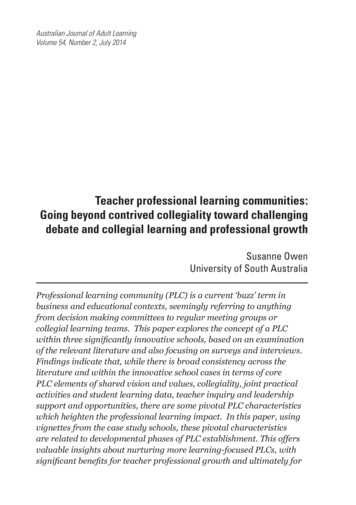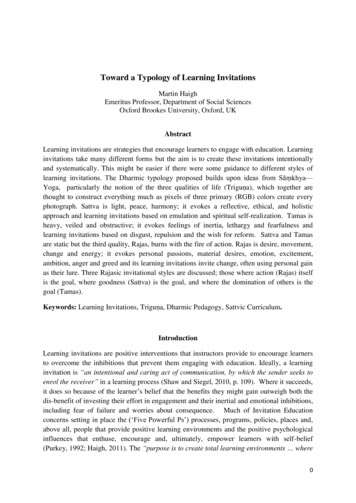
Transcription
Toward a Typology of Learning InvitationsMartin HaighEmeritus Professor, Department of Social SciencesOxford Brookes University, Oxford, UKAbstractLearning invitations are strategies that encourage learners to engage with education. Learninginvitations take many different forms but the aim is to create these invitations intentionallyand systematically. This might be easier if there were some guidance to different styles oflearning invitations. The Dharmic typology proposed builds upon ideas from Sāṃkhya—Yoga, particularly the notion of the three qualities of life (Triguṇa), which together arethought to construct everything much as pixels of three primary (RGB) colors create everyphotograph. Sattva is light, peace, harmony; it evokes a reflective, ethical, and holisticapproach and learning invitations based on emulation and spiritual self-realization. Tamas isheavy, veiled and obstructive; it evokes feelings of inertia, lethargy and fearfulness andlearning invitations based on disgust, repulsion and the wish for reform. Sattva and Tamasare static but the third quality, Rajas, burns with the fire of action. Rajas is desire, movement,change and energy; it evokes personal passions, material desires, emotion, excitement,ambition, anger and greed and its learning invitations invite change, often using personal gainas their lure. Three Rajasic invitational styles are discussed; those where action (Rajas) itselfis the goal, where goodness (Sattva) is the goal, and where the domination of others is thegoal (Tamas).Keywords: Learning Invitations, Triguṇa, Dharmic Pedagogy, Sattvic Curriculum.IntroductionLearning invitations are positive interventions that instructors provide to encourage learnersto overcome the inhibitions that prevent them engaging with education. Ideally, a learninginvitation is “an intentional and caring act of communication, by which the sender seeks toenrol the receiver” in a learning process (Shaw and Siegel, 2010, p. 109). Where it succeeds,it does so because of the learner’s belief that the benefits they might gain outweigh both thedis-benefit of investing their effort in engagement and their inertial and emotional inhibitions,including fear of failure and worries about consequence. Much of Invitation Educationconcerns setting in place the (‘Five Powerful Ps’) processes, programs, policies, places and,above all, people that provide positive learning environments and the positive psychologicalinfluences that enthuse, encourage and, ultimately, empower learners with self-belief(Purkey, 1992; Haigh, 2011). The “purpose is to create total learning environments where0
people want to be and where they want to learn” (Paxton, 2003, p. 23). However, Novak etal. (2014) remind us that learners should be “participants in the exploration of ideas andskills not competing but co-operating in self-correcting ways; [and that] Knowledge is . an active and thoughtful relationship to possibilities” (p.9). There seems to be room forsome additional thinking about different styles of learning invitation.Learning comes in many forms and by several routes: formal learning (that occurs in theclassroom and curriculum), non-formal learning (that occurs outside the curriculum and inless structured learning situations such as sports, clubs, etc.) and informal learning (thatoccurs through daily experience both within and outside the educational establishment butmainly through social interactions in the outside world). Invitational Education, excludesunintentional incidental learning, which happens pretty much at random, but its emphasis onthe ‘5 Ps’ of people, places, processes, programs and policies means that its approach is moreholistic approach than most educational thought. However, while Formal and Non-formallearning are affected by the ‘5Ps’, most Informal and Incidental learning occurs because ofcasual interactions with people, the media and the environment (Task Force on AdultEducation, 2005). Invitational Theory considers four behavioral styles – appropriate, whichinvites learning and inappropriate, which disinvites learning, both of which can be overt orinvisible or covert (Shaw et al., 2013). Together with the unconscious, unintended, impactsof the 5Ps, these invisible or covert interactions create the Hidden Curriculum, which inheresin every learning experience, and help define the boundaries of the Null Curriculum of thatwhich shall not be taught (Kumar, 1992). All too often, this includes both ethical reflectionand anything not firmly embedded especially in Western culture (MacPherson, 2012; Cottonet al., 2013; Haigh, 2009a).The intention of this article is to suggest some theory and a way of expanding, refining andperhaps slightly redirecting the concept of the ‘Learning Invitation’ as it might be applied inthe classroom. It also aspires to push the boundaries of Invitational Education a little widerby emphasizing non-formal educational practices and exposing aspects of the Null andHidden Curricula. The theoretical basis of its core idea has already been introduced toreaders of the JITP in the context of a classroom exercise; this was oriented to encouraginglearners to think about the emotional impacts of their learning environments and the role ofthe ‘Powerful P’ of place (Haigh, 2008). Almost simultaneously, Satish Kumar, disciple ofAcharya Vinoba Bhave and spiritual leader of the Deep Ecology Movement in the UK,published: ‘Spiritual Compass: The Three Qualities of Life’ (Kumar, 2007), using thosesame ideas from the Sāṃkhya-Yoga tradition, as a guide to a sustainable life. Kumar’s (2007)justification was that “we need a spiritual compass to find our direction in life [and to] helpus navigate our path through confusion and crises, through the suffocating allure ofmaterialism, and through delusion and despair” (p.7). For many years, the ideas ofInvitational Education have provided a spiritual compass for those hoping to make theirschools, colleges, curricula and classrooms better, more uplifting, places for learners. Thiscontribution aspires to bring these two traditions together and, in the process, offer moresupport to the classroom teacher.1
One model for this task is Keith Taber’s (2006; 2012) ‘Science Doctor’ guide for Scienceteachers, which offers a typology of the learning impediments experienced by sciencelearners and offers remedies for how to overcome them. This scheme is not ‘InvitationalEducation’, nor is it Sāṃkhya-Yoga; it is negative, allopathic and remedial rather thanpositive, homeopathic and developmental in its approach to learners. Its approach to ‘learningblocks’ is more mechanical rather than spiritual (Figure 1); in other words, it deals more withthe learning process problems and their symptoms rather than the consciousness and selfconcept of the learner as a whole person. However, it is a nice, practical, easy to use,diagnostic tool and the aim, here, is to produce something similar for the construction ofLearning Invitations.Figure 1. Typology of Learning Impediments (modified from Taber, 2006; 2014)The Three Modes of Nature – Some Sāṃkhya – Yoga TheoryThe typology of learning invitations proposed here emerges from Dharmic rather thanWestern thought and, in particular, from the foundational philosophies of Sāṃkhya – Yogaand their concept of the three modes of Nature (triguṇa, guṇa) (Kumar, 2007; Haigh, 2008,Jacobsen, 1999). In Sāṃkhya – Yoga reality has two components: first is the witness, pure,changeless, consciousness (Puruṣa) and second is everything else, material Nature (Prakṛti).Prakṛti contains three strands, modes or qualities (guṇa) (Figure 2). In Sāṃkhya cosmology,originally, these three are in balance and un-manifest but when puruṣa ‘glances’ upon them,they become disturbed and begin a ‘dance’ of combination and recombination creating amyriad of material forms in the process (Davies, 1881; Larson, 2001). As the ‘dance’2
proceeds, the whole diversity of creation evolves and manifests. Everything in nature, everyhuman being, thought or action is an outcome of the interplay of these three modes of nature,which are the primary colors for the whole material universe. In fact, these three qualities(guṇa-s) create and control everything in the material universe in much the same way thatpixels of three primary colors ’RGB’, in different proportions, construct every colorphotographic image. This scheme both massively antedates and reverses Darwin’sevolutionary vision; so, while Darwinian evolution builds upwards from the material worldtowards consciousness, here, consciousness, cognition, constructs everything in the naturalworld, much as it does in most human-created habitats.Figure 2. The Three Modes of Nature (Guṇa-s) and their qualities according to the venerableBhishma in the Mahabharata’s Shanti Parva (Ganguli, 1883-1896).The concept of the three modes of Nature, Triguṇa theory, stands slightly apart fromSāṃkhya – Yoga and has a larger existence that is independent of its roots (Kumar, 2007).The three guṇa-s are Sattva, Rajas and Tamas; they form a ladder where Sattva is the closestto pure consciousness and Tamas is the furthest way. Golden Sattva embodies all that is light,bright, harmonious, sentient and serene; it concerns mindfulness, or now, the presentmoment. Fiery, red Rajas creates everything active and dynamic and that moves because ofdesire or passion; it is the stuff of dreams, plans, ambitions and it concerns the future. Grey,heavy, Tamas restrains everything through inertia, immobility, dullness or banality; itsmothers all beneath fearful helplessness and nostalgia for the past (Harzer, 2005). Everysituation is colored by these three working in different proportions (Haigh, 2008; 2009b).However, Sattva illuminates when Rajas rests and is Tamas exposed; Rajas dominates whenSattva and Tamas are overwhelmed by the desire for action; Tamas obscures when Sattva isignored and Rajas stifled by indolence. For example, in human communication, Sattva is3
dialogue, where truth is brought from within by shared understanding and trust; Rajas isabout diplomacy - it promotes self-interest while offering a smooth and agreeable exterior;while Tamas is about Law and laziness. It is trapped in monologue, unquestioned, and fearfulof argument. Guided by Sattva, the ‘beneficial presence’ (Shaw et al., 2013), Rajasic energycan become creative, the power needed to make something new and good but, guided byTamas, it becomes negative and destructive. However, Sattva alone is merely an enlightenedvision while Rajas alone is just undirected energy and Tamas only insensate immobility; thethree guṇa-s always work together (Prabhavananda and Isherwood, 1953, p. 17-19).Styles of TeachingThe three modes affect everything; this includes teaching. So, in education, Tamasic teachingis oppressive, prescriptive, shallow, and oriented to unquestioning memorization; it is the‘lethal presence’ of Invitational Education (Shaw et al., 2013). The Tamasic teacher issomeone who, demanding obedience and discipline, lays down the law of what must beknown, what must be done, what is right and what wrong, whether this be true or not. For theTamasic teacher, learners are empty vessels to be filled with information and skills, which arefinal, static, and uncontestable; their progress is assessed by parrot-like recitations ofmemorized facts, lore and law as in much multiple-choice testing. Sometimes, Tamasicteaching happens simply because a teacher is out of their depth and fearful of their subjectmatter. Ram Dass (1973) memorably described some ‘math-averse’ school teachers as‘plague carriers’ because of their tendency to spread negative attitudes towards mathematicsamong learners. Of course, Tamasic teaching corrupts any source material and deflateslearner enthusiasm.However, Tamasic teaching is more than ‘bad teaching’; sometimes, it is constructeddeliberately for the purposes of social control, disempowerment and repression (Kali Ma,2013). Bay notes: “ much of what is going on in our schools and universities I wouldrather refer to as training, molding, socialization, mystification, memorizing of facts,obfuscation of meaning to produce intelligent citizens to execute jobs faithfully and notask any questions about their meaning or purpose or value.“ (Bay, 1981, p.77). Philip Riner(2010) adds: “At large, great effort is exerted for individuals to conform in all types of socialorganizations from family units, to schools, to the workplace, and even nations to have the“right” view where “right” is provided pre-packaged and not subject to inquiry” (pp 103104).Different styles of Tamasic teaching appear with admixed with more Rajas. Some teaching,as in old-fashioned Technical Education, is designed to produce tools, automata, unthinkinghuman robots with ‘correct’ skills and attitudes. Learning is enforced by coercion, throughfear of failure in tests or by other species of ‘name and shame’. Teaching is conducted by ateacher who is already proficient; the role of the learner is to become a ‘mini-me’ replica ofthat teacher. Driven by the micro-managerial enforcement of performance standards,teachers are also becoming encouraged to act as robots. For both teacher and learner,standards are enforced by performative examinations, while innovation, originality, and4
autonomy are discouraged and often punished.The aim is to produce someone whoperforms, reliably, according to predesigned specifications, i.e. a robot.Rajasic teaching emphasizes performance. It aims to inspire learners to target success,recognition, ‘progress’ and ‘profit’. Rajas bathes in reflected glory, it is less about being agood, ethical person with a secure ethical and spiritual compass than about winningadmiration, wealth, power, spectacle and performance. In education, “Success is defined asdoing well academically, behaviorally and socially. Therefore, students who choose tobehave in ways which provide rewards, success, and acceptance by others are said to have apositive self-concept or success identity” (Zeeman, 2006, p.15).In the modern world, Rajas may dominate the entire educational process. Its mantra ofchange, action at all costs, reduces ultimately to action for the sake of action. For the Rajasic,new is always better, change is always good, hence it encourages the development of skills,projects and the endless fixing (or disposal of) that which is not broken. Rajasic teaching isalways goal driven; it emphasizes optimism about future benefits, and the ways of achievingthose benefits. This involves analysis of the task, operations research, logistics, focusing onwhat is ‘important’ and working, efficiently, step by step. However, inevitably, this focusleads learners to see things in isolation and separation; Rajas encourages a reductionistunderstanding.The Indian epic, the Mahabharata, contains the story of the Pandava brothers’ archeryexamination; their teacher offers them a target and asks what they can see? The saintly,Sattvic, Yudhishthira, sees the target, the tree where it stands, his brothers and himself. Hedoes not pass the test. His brother, the heroic, Rajasic, Arjuna sees nothing but the eye of thetarget; he passes (Ganguli, 1883-1896, Mahabharata, Adi Parva, Sambhava Parva, Section124-125). Later, Arjuna preserves his being ‘the best’ by having a rival of superior skilldisabled. Rajas breeds pride, discrimination, and a host of other destructive attitudes and itpervades our modern world. Rajasic teaching may develop leadership qualities and the abilityto inspire trust in others but its intentionality is self-serving and, ultimately, amoral (Purkey,1991). Always, it appeals to ambition and serves some distant, usually selfish, goal, perhapsdefined by the ephemera of shifting fashion. Hence, it causes restlessness, dissatisfaction,envy, greed, stress and sorrow. To escape the destructive consequences of Rajas, it isnecessary to move beyond pride, desire, thoughts of possession, and the eternal enthusiasmfor action. It is necessary to see the world as more than an exterior of individual objects.Sattvic teaching evokes Puruṣa, the silent witness, and peace; in Invitational Theory, it is the‘beneficial presence’ (Shaw et al., 2013). It encourages learners to see things as a whole; itevokes synthesis and holistic learning, it values the eternal and not the ephemeral. It worksby setting a good example for learners to emulate. For example, Eknath Easwaran describeshow he followed the example of his role model, Mahatma Gandhi, emulating his method of‘experimentation with Truth’ (Easwaran, 1989). Elsewhere, Western Buddhist teacherspromote ‘Contemplative Education’, which employs meditation to enhance calm and selfawareness (Hart, 2004, Bush, 2010; Bai et al., 1999). Sattvic teaching, then, promotes5
mindfulness, compassion, reflection, ethical awareness and the holistic perspective, and anappreciation of both unity and interdependence in the world (Hanh, 2013).Learning InvitationsSo, everything in the material universe is created by a particular combination of three primaryqualities or ’Guṇa-s’. Two are static opposites, Sattva, which is light, and Tamas, which isdark and heavy (Harzer, 1995). The third is an active agency, Rajas, which can pull towardseither Sattva or Tamas. The task of most Learning Invitations is to encourage the learner touse Rajas, their own volition, to rise above Tamas and move in the direction of Sattva (Haigh,2010a), albeit sometimes no further than Rajas itself.Table 1.Five types of Learning Invitation.Invitation TypeApplied Motivation (Rajas)ExampleSattvicAttraction by good example. The role model (Acharya; Bodhisattva,saint, Gandhian-style leader) inspires thelearner who resolves to follow their path.Rajo-sattvicThe will to do good.Compassion, empathy and the desire tomake situations better.RajasicAction for the sake ofactivity.The joy of accomplishment, the ‘adrenalinrush’, thrill, the self-assertion that gains theadmiration and respect of others.Rajo-tamasicThe will to win and todefeat.The lure of ‘victory’, the learner isencouraged to be the best, to compete, towin, to defeat and destroy rivals and so,ultimately, ‘beggar their neighbor’.TamasicRepulsion from badexample.Darpana Guru – the teacher acts as a mirrorthat shows learners unpleasant aspects ofthemselves or their life and so invites themto change for the better.Five types of Learning Invitation are suggested (Table 1). Two, dominated by the qualities ofSattva or Tamas, are mainly static. Three, dominated by Rajas, engage action for its ownsake, through repulsion from Tamas, or, through attraction, to get closer to Sattva. Hence,Sattvic learning invitations involve the display of a good example to be emulated, whileTamasic learning invitations display a bad example, often in the form of a mirror, to berejected. Of course, the typical learning invitations of Invitational Theory and Practice areRajasic; they invite conscious action as in the similes of the dance or model of the ‘5P’starfish (Novak et al., 2014, Haigh, 2011). Rajasic learning invitations motivate, energizeand sustain action and change through inspiring developing enthusiasm and, usually, personalambition. Learning Invitations wholly dominated by Rajas, invite action for the sake of6
activity or for Rajasic values such as competition, thrill seeking, or the construction ofpersonal self-esteem and pride.Tamasic Learning InvitationsTamasic Learning Invitations are the most perverse and dangerous. Their aim is to play‘Devil’s Advocate’ by providing an intentional display of bad practice with the intention ofprovoking positive learning as a reaction. These kinds of Learning Invitations are central tomuch case-study analysis in the applied disciplines: engineering, medicine, business, etc.Here, the case describes some kind of problem, failure or disaster. The question addressed inclass becomes what went wrong, what can be done to prevent a recurrence and what, ingeneral and theoretical terms, can be learnt from the experience? Learning from pastmistakes is a fundamental part of education and central to the theories of preventative,reactive and aspirational ethics (Harris et al. 2005).Another class of Tamasic Learning Invitations is that associated with the ‘Crazy Wisdom’style of teaching (Feuerstein, 1990). Here, the role of the teacher is to hold a mirror to thelearner that demonstrates their own failings and signals a path to self-improvement anddevelopment. For example, the Puranas tell a story about King Ayu’s quest for a son, whichleads him to approach the Sage Dattātreya (Haigh, 2012). When he appears, Sri Dattātreyaassumes the form of a dissolute oriental potentate, King Ayu in other words: “Dattātreya, hiseyes red due to spirituous liquor, was sporting with women. sang, danced, and heavily drankliquor. The best of the meditating saints, without a sacred thread.” (Padma Purana2.103.110-113 in: Shastri et al., 1989). Thus, Dattātreya set the learner the challenge ofrejecting their own behavior and to aid this holds up a mirror (Markandeya Purana 17.17-24in: Pargiter, 1904). Of course, the King recognizes Lord Visnu beneath the theatrical mask,created from his own personal failings, and so reforms his way of life and obtains his desire(Padma Purana 2.103.124-138 in: Shastri et al., 1989). In modern America, the Guru Adi Dataught for 16 years using ’Crazy Wisdom’ “theatrically dramatizing his [learners] habits,predilections, and destinies” (Bonder, 1990, pp 449-451). Again, my Department’s guidanceto student project teams on the arts of interviewing includes some amateur dramatics in whichteachers role-play under-prepared or uninterested student interviewers and uncooperative ordistracted interviewees. The aim is to highlight the pitfalls and problems of the interviewtechnique. However, while this interlude has been much enjoyed by all involved, clearly,some learners only see the problems of the interviewee, ignore the mirror held up to theirown behavior, and make precisely the same errors in their own research practice. Of course,the danger of using such Tamasic learning invitations is that they may not be recognized andall kinds of damage can be the consequence. As, Sage Bhishma cautions that Tamas has 3outcomes: incomprehension, partial comprehension, and miscomprehension (Ganguli, 18831896, Mahabharata, Santi Parva, Section 302). By contrast, a Tamasic invitation to learningrelies on combining Rajas with the Sattvic power of reflection and the ability to recognizeand learn from mistakes – especially one’s own.The problems inherent in using Tamasic Learning Invitations are compounded by the factthat so much in education is already, genuinely, Tamasic. If it is not actively dis-invitational,7
then it aims to pulls the learner toward Tamas, guided action by promoting distinctionsbetween ‘us and them’. As such, it may invite a whole array of negative attitudes: not onlyTamasic qualities such as hedonism, laziness, callousness, but also Tamasic Rajas expressedthrough xenophobia, chauvinism, egotism, dogmatism, sexism, racism, in fact, a whole arrayof ‘beggar-thy-neighbor’ attitudes. Tamas alone may be inert, sullen and negative; it attractslearners through laziness, carelessness, as well as fear and despondency. However, mixedwith a little Rajas, it can provide the base for action motivated by negative desires such asanger, greed, envy, lust, and hatred that can transform disgust, envy, and feelings ofsuperiority/inferiority into denegation or destruction. Rosandic (2000) describes how Serbianschoolbooks and schooling helped construct the roots for the 1990s war, beginning withteaching that functioned as the transmission of directives that reinforced paternalism, thatemphasized the over-arching need for preservation of the community against all outsiders andthat contained the presumption, indeed glorification, of conflict. Of course, the whole field ofPeace Education exists to transform the similar Tamasic qualities that exist in the educationalsystem of all nations; “the classroom is a microcosm of the world; it is the chance we have topractice whatever ideals we may cherish. The kind of class-room situation one creates is theacid test of what it is one really stands for” (Tompkins, 1990, p. 656).Rajasic Learning InvitationsSome purely Rajasic Learning Invitations invite action for the sake of action itself; thepaybacks are adrenalin and dopamine hormonal releases. However, most Rajasic LearningInvitations motivate learners by offering the glittering prizes and possibilities of selfimprovement, often competitive self-improvement; the invitation is that they will becomewealthier, more respected, more attractive sexually, and gain a better situation in the materialworld. Rajasic Learning Invitations inspire the learner to be a success, a winner; they evokethe desire to triumph, to achieve, to solve and to create. Of course, they permeate theideology of teachers and teaching that aims to inspire, to enthuse, to instill passion and thewill to succeed. Hence, Rajas includes all forms of active ‘learning by doing’: Constructivistproblem solving, experimentation, analysis, classification, action to engage with experience,as well as any form of competition.Inevitably, Rajas dominates Sports, Leadership, Management, Enterprise and Businesseducation, where the aim really is to produce ‘winners’. However, “for all too many of thepundits, politicians, corporate leaders and others, education is a business and should betreated no differently from any other business” rants Apple (2006, p.1). Of course, on acertain level, Rajas works. The Rajasic qualities of achievement motivation andconscientiousness proved the strongest associates of academic success in a major study ofEuropean Psychology undergraduates (Busato et al., 2000). However, the associate of Rajasis also selfishness and egotism (e.g. Grayling, 2015).Today, education is trapped in a culture of performativity where, Rajas, current and futureperformance is everything. “Performativity is a technology, a culture and a mode ofregulation that employs judgements, comparisons and displays as means of incentive, control,attrition and change based on rewards and sanctions (both material and symbolic) 8
performances . serve as measures of productivity or output, or displays of ‘quality’ [and]represent the worth, quality or value of an individual or organization” (Ball, 2006, p.144).For many years, teachers applied these measures to learners and today, they are beaten withthe same stick and offered the same carrot of success. “Last year’s efforts are a benchmarkfor improvement – more publications, more research grants and more students. We must keepup; meet the new and ever more diverse targets ” Ball (2012, p.30).Rajasic learning invitations appeal to the self-serving and animal instincts within everyhuman, as in animal behavior, action is geared to the reward offered and reinforced byconditioning (Powell et al, 2008). Positive and negative reinforcements defined thetransformative pivot points in the experience of 640 undergraduates, where a tutor-learnerinteraction had a major impact affect, either positive or negative, on learning (DorcanMorgan, 2009). Often the interaction involved discussion of grades, assignments or coursecontent and, sometimes, punishment, perhaps expressed as ridicule/discipline or a shamereaction to bad grades, which, commonly, had Tamasic effect leading to reduced learning(Turner et al, 2013).By contrast, a study of Hispanic undergraduates in the USA, found academic achievementvalued as a way of honoring the struggle and sacrifice of parents, a more Sattvic motivation(Easley et al. (2012). As sage Bhishma reminds: Rajas has two outcomes the will to act and,ultimately, to sorrow, when that action is no longer possible, goes wrong or otherwise isunsatisfying, while Sattva’s only outcome is enlightenment (Ganguli, 1883-1896,Mahabharata, Santi Parva, Section 302).Sattvic Learning Invitations“Don’t just do something, stand there” advise Business Gurus Weisbord and Janoff (2007,p.1) attempting to overcome unproductive reactivity in meetings. In the Sattvic state, thelearner just looks and learns; here, they are closest to Puruṣa, the inactive, detached,conscious witness. Purely Sattvic learning invitations are static and calm. Typically, theyinvolve peace of mind, conscious reflection and detachment from the Rajasic froth ofmaterial existence. The key is reminding the Self that it is not the doer – only the witness –and developing the detachment to see the dance of Prakṛti for what it is – simply a spectacle(e.g. DeBord, 1967).Rajas strives for the future, while Tamas lounges in the past, but Sattva rests in this momentnow. Being in the present moment is not easy. However, the mind can be steered away fromfidgeting about what may happen in the future, what might have happened in the past or whatmight be ‘if only’, and if it can, it can be freed from a great deal of unhelpful stress anddistraction and better able to deal with the current situation (Bays, 2011). The purpose ofYoga, of course, is to still the fluctuations of the mind (Patañjali's Yoga Sutras 1.2-1.4;Prabhavananda and Isherwood, 1953). Only then does it become possible to be fully alive asyour true self rather than some fantasy concocted from desires, dreams, angsts and worries.To escape these, it is necessary to construct some dispassionate detachment from the tumultof everyday life. One exercise employed by a course on ‘Stress Management and9
Forgiveness’ at the College of Vedic Studies (UK), involved learning how to stop ‘drinkingthe poison’ of brooding and resentment. We all brood about the injustices meted out to us,real and imagined, but brooding and angst do nothing about the injustice – they only damagethe one who broods. So our teacher, Mahatma Das, invited us to write a list of all thosethings than cause u
diagnostic tool and the aim, here, is to produce something similar for the construction of Learning Invitations. Figure 1. Typology of Learning Impediments (modified from Taber, 2006; 2014) The Three Modes of Nature - Some . Sāṃ. khya - Yoga Theory . The typology of learning invitations proposed here emerges from Dharmic rather than
